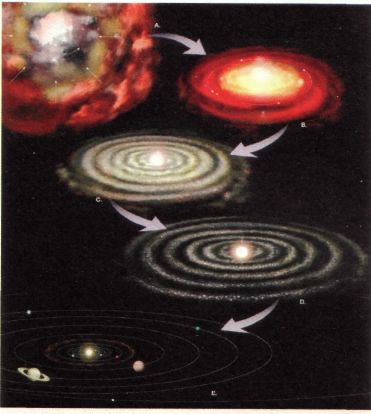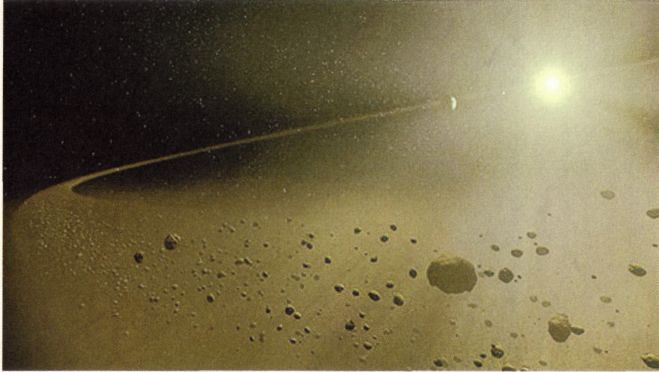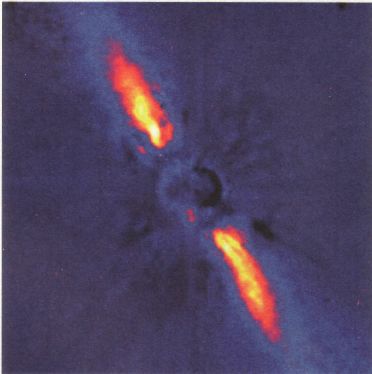So Newton was wrong in both senses: (a) in the sense of believing that the chaotic distribution of cometary orbits is what you would expect in a primordial system and (b) in assuming that there was no natural way in which the regularities of planetary motion could be understood without divine intervention, from which he deduced the existence of a Creator.
Well, if Newton could be fooled, this is something worth paying attention to. It suggests that we, of doubtless inferior intellectual accomplishment, might be vulnerable to the same sort of error.
I would just like to lock in what I've been saying about the solar nebula with three more images.
Here is an attempt to illustrate what I've just been saying. An originally irregular interstellar cloud is rotating. It gravita-tionally contracts; that is, the self-gravity pulls it in. Because of the conservation of angular momentum, it flattens into a disk. A way to think of it is that centrifugal force does not oppose the contraction along the axis of rotation but does in the plane of rotation. So you can see that the net result will be a disk. Through processes that need not detain us here (although remarkable progress has been made in our understanding during the last twenty years), there are gravitational instabilities that produce a large number of objects, which then fall together by collision and produce a smaller number of objects. It's clear that

if there were a huge number of objects with crossing orbits, they would eventually collide, and you would wind up with fewer and fewer objects. So the idea here is that there is a kind of collisional natural selection-the evolutionary idea as applied to astronomy-in which you must eventually wind up with a small number of objects in orbits that do not cross each other. And that is certainly the present configuration of the planetary system shown up here.
This is just another artist's conception of an early stage in the origin of our solar system, showing some of the multitude of small objects a few kilometers across, from which the planets were formed. And that this is not solely a theoretical construct has been made clear in recent years by the discovery of a number of flattened disks around nearby stars.


This one is around the star Beta Pictoris. It's in a Southern Hemisphere constellation. But Vega, one of the brightest stars in the Northern sky, also has such a flattened disk of dust and maybe a little gas around it. And many people think that it is in the final stages of sweeping up a solar nebula, that planets have already formed there, and that if you come back in only a few tens of millions of years you will find the disk entirely dissipated and a fully formed planetary system.
So I would like now to come to what is called the anthropic principle. If you study history, it's almost irresistible to ask the question, what if something had gone in a different direction? What if George III had been a nice guy? There are many questions; that's not the deepest, but you understand what I'm saying. There are many such apparently random events that could just as easily have gone another way, and the history of the world would be significantly different. Maybe-I don't know that this is the case-but maybe Napoleon's mother sneezed and Napoleon's father said, 'Gesundheit,' and that's how they met. And so a single particle of dust was responsible for that deviation in human history. And you can think of still more significant possibilities. It's a natural thing to think about.
Now, here we are. We're alive; we have some modest degree of intelligence; there is a universe around us that clearly permits the evolution of life and intelligence. That's an unremarkable and, I think, as secure a remark as can be made in this subject: that the universe is consistent with the evolution of life, at least here. But what is interesting is that in a number of respects the universe is very fine-tuned, so that if things were a little different, if the laws of nature were a little different, if the constants that determine the action of these laws of nature were a little different, then the universe might be so different as to be incompatible with life.
For example, we know that the galaxies are all running away from each other (the so-called expanding universe). We can measure the rate of expansion (it is not strictly constant with time). We can even extrapolate back and ask how long ago were all the galaxies so close that they were in effect touching. And that will surely be, if not the origin of the universe, at least an anomalous or singular circumstance from which we can begin dating. And that number varies according to a number of estimates, but it's roughly 14,000 million years.
Now, the period of time that was required for the evolution of intelligent life in the universe-if we are unique and we define ourselves immodestly as the carriers of intelligent life (a case could be made, you know, for other primates and dolphins, whales, and so on)-but for any of those cases it took something like 14,000 million years for intelligence to arrive. Well, how come? Why are those two numbers the same? Put another way: If we were at a much earlier stage or a much later stage in the expansion of the universe, would things be very different? If we were at a much earlier stage, then there would not be, according to this view, enough time for the random aspects of the evolutionary process to proceed, and so intelligent life would not be here, and so there would be nobody to make this argument or debate about it. Therefore the very fact that we can talk about this demonstrates, it is argued, that the universe must be a certain number of years old. So if only we had been wise enough to have thought of this argument before Edwin Hubble, we could have made this spectacular discovery about the expansion of the universe just by contemplating our navels.
There is to my mind a very curious ex post facto aspect of this argument. Let's take another example. Newtonian gravitation is an inverse square law. Take two self-gravitating objects, move them twice as far apart, the gravitational attraction is one-quarter; move them ten times farther apart, the gravitational attraction is one- hundredth, and so on. It turns out that virtually any deviation from an exact inverse square law produces planetary orbits that are, in one way or another, unstable. An inverse cube law, for example, and higher powers of the negative exponent mean that the planets would rapidly spiral into the Sun and be destroyed.
Imagine a device with a dial for changing the law of gravity (I wish there were such a device, but there isn't). We could dial in any exponent, including the number 2 for the universe we live in. And when we do this, we find that a large subset of possible exponents leads to a universe in which stable planetary orbits are impossible. And even a tiny deviation from 2-2.0001, for example-might, over the period of time of the history of the universe, be enough to make our existence today impossible.
So, one may ask, how is it that it's exactly an inverse square law? How did it come about? Here is a law that applies to the entire cosmos that we can see. Distant binary galaxies going around each other follow exactly an inverse square law. Why not some other sort of law? Is it just an accident, or is there an inverse square law so that we could be here?
In the same Newtonian equation, there is the gravitational coupling constant called 'big
Or if the Newtonian gravitational constant were ten times less, then we would have only red dwarf stars. What's wrong with a universe made with red dwarf stars? Well, it is argued, they're around for a long time because they burn their nuclear fuel slowly, but they are such feeble sources of light that to be warmed to the temperatures of liquid water, let's say, [2] then the planets would have to be very close to the star in order to be at this temperature. But if you put the planets very close to the star, there is a tidal pull that the star exerts on the planet so that the planet always keeps the same face to the star, and therefore, it is said, the near side will be too hot and the far side will be too cold and it's inconsistent with life. So

